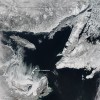Climate
Sea ice in the Gulf of St. Lawrence
|
The Gulf of St. Lawrence, the outlet of the Great Lakes into the Atlantic Ocean, is building toward its annual peak accumulation of sea ice, according to a recent photograph captured from NASA’s Aqua satellite. According to NASA, each year, the amount of frozen seawater, known as sea ice, in the Arctic Ocean builds from September through February or March as surface air temperatures drop below freezing. As it reaches the peak of its expansion, it begins to form in the Gulf of St. Lawrence.






